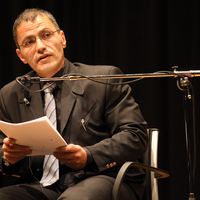
Simay Yılmaz
Theatre studies, musical theatre, actor's voice.
less
Related Authors
Pieter Verstraete
University of Groningen
Vayos Liapis
Open University of Cyprus
Anna Tabaki
National & Kapodistrian University of Athens
Eleni Papalexiou
University of the Peloponnese
Manolis Seiragakis
University of Crete
Avra Xepapadakou
University of Nicosia
Kaiti Diamantakou
National & Kapodistrian University of Athens
Sean Metzger
University of California, Los Angeles
George P . Pefanis
National & Kapodistrian University of Athens
Freddie Rokem
Tel Aviv University










Uploads
Papers by Simay Yılmaz
It has been observed that the plot centers on the theme -the absurdity of human portraying passengers on a ferry who talk without taking action. Modern individualism and lack of communication are layers of thought, conveyed effectively through the use of self-centered monologues instead of meaningful dialogues. Symbolism plays a crucial role, with characters as anonymous figures lacking depth or development, representing various human portraits or traits. The vagueness in time and setting allows the plot to embrace ‘anytime’ / ‘anyplace’ where the modern individual exists. Additionally, the use of humor enables readers to engage with the critical perspective. In conclusion, Anday’s play exemplifies the influence of the playwriting tendencies of “The Theater of the Absurd” to a significant extent, thus serves as a notable example of the absurdist influence in modern Turkish Theater.
Yirminci yüzyılın başındaki avant-garde sanat akımlarından biri olan Ekspresyonizm, sahne sanatlarını büyük ölçüde etkilemiştir. Bilhassa tiyatro sanatı özelinde başat açılımlara olanak sağlayan ekspresyonist akımın havası, takip eden dönemlerdeki sanatsal eğilim ve yönelimlerde de solunmaya devam etmiştir. Bu çalışmada, ekspresyonist akımın tiyatro sanatı bağlamındaki özelliklerinin incelenmesi amaçlanmıştır. Çalışmanın yöntemini, detaylı bir literatür taraması ve analizi, ardından toplanan verinin alt başlıklar altında kümelenmesi oluşturmuştur. Çalışmada, sırasıyla, yirminci yüzyılın öncü sanat akımlarını hazırlayan toplumsal koşullar açıklanmış, Ekspresyonizm akımının genel özelliklerine yer verilmiş, ekspresyonist tiyatronun öncüleri, ortaya çıkış ve gelişim süreci ele alınmış ve son olarak Ekspresyonizmin tiyatro sanatına etkisi, oyun yazımı ve sahneleme özellikleri bağlamında incelenmiştir. Çalışmanın sonucunda, ekspresyonist akımın, oyun yazımında Stationendrama tekniğinin benimsenmesi, olay örgüsünün mantığa ve neden-sonuç ilişkisine dayanan yapısının bozulması, sahnelemede teatralliğin, grotesk ve stilize oyunculuk unsurlarının kullanıma sokulması, natüralist sahne tasarımından uzaklaşılarak soyutlamaya ve çarpıtmaya yönelinmesi, ışık ve sesin anlatımın önemli araçları haline gelmesi gibi bir dizi önemli yeniliği tiyatro sanatına kazandırdığı görülmüştür.
Anahtar Kelimeler: Ekspresyonizm, Ekspresyonist Tiyatro, Ekspresyonist Oyun Yazımı, Ekspresyonist Sahneleme, Sahne Sanatları
ABSTRACT
Expressionism, one of the early twentieth century avant-garde art movements, had a major effect on the performing arts, especially in theatre and its related genres. Thus, this study examined the features of the Expressionist movement in theatre. For this purpose, we conducted a detailed literature review and analysis, and examined the social conditions that fostered the twentieth century avant-garde art movements, general characteristics of Expressionism, emergence of Expressionist theatre, and its pioneers, development process, and effect on theatre in the context of playwriting and staging. Based on the findings, Expressionism brought a number of important innovations to theatre, including the adoption of the Stationendrama technique in playwriting; destruction of the structure of the plot (which was primarily based on logic and a cause-effect relationship); use of theatricality, grotesque, and stylized elements in acting; disengagement from the naturalistic stage design and tendency toward abstraction and distortion; and use of light and sound, as important tools of expression.
Keywords: Expressionism, Expressionist Theatre, Expressionist Playwriting, Expressionist Staging, Performing Arts
İnsan topluluklarının en temel kültürel örüntülerinden olan ritüeller, kültürün araştırılmasında en çok başvurulan unsurlardandır. Arnold Van Gennep’in “geçiş ritüelleri” kuramı ve bu kuramın üzerine inşa edilmiş olan Victor Turner’a ait “eşiksellik” kuramı ise, sosyal bilimlerin ritüel çalışmalarının en temel kuramlarıdır. Bu kuramlara göre, hayatın çeşitli aşamalarında ve mecralarında “geçiş ritüelleri” bulunmaktadır ve bu ritüeller üç aşamaya ayrılmış şekilde seyretmektedir. Bu aşamaların ikincisi olan “eşiksel” aşama, bireylerin ne ilk ne de son aşamada olduğu bir ‘aradalık’ hali ile karakterize olmuştur. Kuramsal tarihi boyunca ritüeller ile benzeştirilmiş, hatta ritüellerin içerisinden doğup salt sanatsal kimliğini kazandığı öne sürülmüş olan sahne sanatları temsilleri, bu çalışmada, ritüellerle olan benzerliğinin değerlendirilmesi amacıyla iki temel ritüel kuramı olan “geçiş ritüelleri” ile “eşiksellik” bağlamında ele alınmıştır. Araştırmada, öncelikle, detaylı bir literatür taraması gerçekleştirilmiş ve kuramsal çerçeve oluşturulmuştur. Daha sonra, oluşturulan kuramsal çerçeve ışığında, sahne sanatları temsillerinin gözlemlendiği ve sahne sanatları çevresi ile birebir görüşmelerin gerçekleştirildiği bir alan araştırması yürütülmüştür. Araştırmanın sonucunda, yüzyıllardır ritüeller ile bir arada ele alınmış olan sahne sanatları temsillerinin hem “geçiş ritüellerinin” üç basamaklı yapısı hem de Victor Turner’ın ikinci aşama üzerine inşa ettiği “eşiksel” evrenin özellikleri ile uyum içerisinde olduğu ve bu kuramlar bağlamında yapılan değerlendirmenin sahne sanatları temsillerinin ritüellerle benzeştiği fikrini pekiştirdiği sonucuna varılmıştır.
Anahtar Kelimeler: Sahne Sanatları, Eşiksellik, Geçiş Ritüelleri
ABSTRACT
Rituals are one of the most studied concepts in the research of culture. Arnold Van Gennep’s theory “rites of passage” and Victor Turner’s theory “liminality” are together the most basic theories of ritual studies. According to these theories, there are “transition rituals” at various stages and in various channels of life and these rituals are divided into three stages. The second stage is called “liminality” and is characterized by an ‘in-betweenness’ in which individuals are neither in the first nor at the last stage. In this study, the field of performing arts, which has always been viewed in terms of rituals and, indeed, is said to be born out of them having gained its purely artistic identity later on, is examined in the context of the “rites of passage” and “liminality” theories, in order to evaluate its similarity with the rituals. After a detailed literature review, this study builds a conceptual and theoretical framework for the research. Having done that, we then explain how we conducted our field research which involved participant observation and face-to-face interviews, all in the light of the afore-mentioned framework. The results of the study conclude that performing arts, which have been considered together with rituals since their theoretical beginning, share the principles of the three staged “transition rituals” and the characteristics of the “liminal” stage coined by Victor Turner. The study also concludes that the theoretical framework supports the idea that performing arts are similar to rituals.
Keywords: Performing Arts, Liminality, Rites of Passage
1880-1900’lü yılların Rus toplumu yüzyılın başlarından itibaren toplumsal yaşama etki eden modernleşme, sanayileşme ve toplumsal değişimin izlerini taşımaktadır. Anton Pavloviç Çehov’un oyunlarında bu sosyal değişim sürecinin bireysel ve toplumsal izlerine rastlanmaktadır. Bu makalenin amacı, Rus toplumsal değişim sürecinin Çehov oyunlarındaki yansımalarının sosyal bilimler kuramları bağlamında analiz edilmesidir. Çalışmada, söz konusu kuramlara ilişkin literatür taraması ışığında, Anton Pavloviç Çehov’un “İvanov”, “Vişne Bahçesi”, “Üç Kız Kardeş”, “Martı” ve “Vanya Dayı” isimli büyük oyunlarının incelemesi gerçekleştirilmiştir. Çalışmanın sonucunda; geleneksel toplum yapısından modern toplum yapısına geçişte, bireylerin hayatı anlamlandırış biçimleri ve değerler sisteminin çöküşü ve değişikliğe uğraması sebebiyle anlam arayışı, umutsuzluk ve amaçsızlığa sürüklendikleri; ayrıca toplumsal alanda mücadele edebilmelerini sağlayan ve sınıfsal konumlarını belirleyen ekonomik, sosyal ve kültürel sermaye türlerine sahip oldukları ve toplumsal dinamiklerin değişimi ile bu sermaye türlerinin de el değiştirebildiği, kaybedilebildiği veya kazanılabildiği; bireylerin ise sahip oldukları sermaye türlerini kaybetmeme eğiliminde oldukları sonuçlarına varılmış; bu sonuçlar Anton Pavloviç Çehov’un oyunlarında örneklenerek incelenmiştir.
Anahtar Kelimeler: 19. Yüzyıl Rus Edebiyatı, Anton Çehov, Rus Modernleşmesi
ABSTRACT
Chekhov Plays in Terms of the 19th Century Russian Social Transformation: The Examples of “Ivanov,” “The Cherry Orchard,” “Three Sisters,”“The Seagull,” and “Uncle Vanya”
The Russian society of 1880–1900’s shows the effects of the modernization, industrialization, and social change, which had been affecting social life since the beginning of the century. In Anton Chekhov’s plays, we encounter the effects of social change on individuals and society. The aim of this article is to analyze the examples related to the Russian social transformation in Chekhov’s plays using certain social sciences theories. During this study, Anton Chekhov’s great plays“Ivanov,”“The Seagull,”“Uncle Vanya,”“Three Sisters,”and“The Cherry Orchard”were analyzed after a literature review on mentioned social sciences theories. As a result of this study, it is concluded that during the transition from the traditional society to modern society, the way that individuals perceived their lives and their system of values changed. As a result of this change, individuals were dragged into a search of meaning, hopelessness, and purposelessness. Additionally, individuals owned economic, social, and cultural capital, which enabled them to cope in social arenas, and which determined their social class. With the change of social dynamics, these types of capital could pass into different social classes, and individuals tried to not lose the capital that they owned. These results have been exemplified in plays of Chekhov.
Keywords: 19th Century Russian Literature, Anton Chekhov, Russian Modernization
Books by Simay Yılmaz
It has been observed that the plot centers on the theme -the absurdity of human portraying passengers on a ferry who talk without taking action. Modern individualism and lack of communication are layers of thought, conveyed effectively through the use of self-centered monologues instead of meaningful dialogues. Symbolism plays a crucial role, with characters as anonymous figures lacking depth or development, representing various human portraits or traits. The vagueness in time and setting allows the plot to embrace ‘anytime’ / ‘anyplace’ where the modern individual exists. Additionally, the use of humor enables readers to engage with the critical perspective. In conclusion, Anday’s play exemplifies the influence of the playwriting tendencies of “The Theater of the Absurd” to a significant extent, thus serves as a notable example of the absurdist influence in modern Turkish Theater.
Yirminci yüzyılın başındaki avant-garde sanat akımlarından biri olan Ekspresyonizm, sahne sanatlarını büyük ölçüde etkilemiştir. Bilhassa tiyatro sanatı özelinde başat açılımlara olanak sağlayan ekspresyonist akımın havası, takip eden dönemlerdeki sanatsal eğilim ve yönelimlerde de solunmaya devam etmiştir. Bu çalışmada, ekspresyonist akımın tiyatro sanatı bağlamındaki özelliklerinin incelenmesi amaçlanmıştır. Çalışmanın yöntemini, detaylı bir literatür taraması ve analizi, ardından toplanan verinin alt başlıklar altında kümelenmesi oluşturmuştur. Çalışmada, sırasıyla, yirminci yüzyılın öncü sanat akımlarını hazırlayan toplumsal koşullar açıklanmış, Ekspresyonizm akımının genel özelliklerine yer verilmiş, ekspresyonist tiyatronun öncüleri, ortaya çıkış ve gelişim süreci ele alınmış ve son olarak Ekspresyonizmin tiyatro sanatına etkisi, oyun yazımı ve sahneleme özellikleri bağlamında incelenmiştir. Çalışmanın sonucunda, ekspresyonist akımın, oyun yazımında Stationendrama tekniğinin benimsenmesi, olay örgüsünün mantığa ve neden-sonuç ilişkisine dayanan yapısının bozulması, sahnelemede teatralliğin, grotesk ve stilize oyunculuk unsurlarının kullanıma sokulması, natüralist sahne tasarımından uzaklaşılarak soyutlamaya ve çarpıtmaya yönelinmesi, ışık ve sesin anlatımın önemli araçları haline gelmesi gibi bir dizi önemli yeniliği tiyatro sanatına kazandırdığı görülmüştür.
Anahtar Kelimeler: Ekspresyonizm, Ekspresyonist Tiyatro, Ekspresyonist Oyun Yazımı, Ekspresyonist Sahneleme, Sahne Sanatları
ABSTRACT
Expressionism, one of the early twentieth century avant-garde art movements, had a major effect on the performing arts, especially in theatre and its related genres. Thus, this study examined the features of the Expressionist movement in theatre. For this purpose, we conducted a detailed literature review and analysis, and examined the social conditions that fostered the twentieth century avant-garde art movements, general characteristics of Expressionism, emergence of Expressionist theatre, and its pioneers, development process, and effect on theatre in the context of playwriting and staging. Based on the findings, Expressionism brought a number of important innovations to theatre, including the adoption of the Stationendrama technique in playwriting; destruction of the structure of the plot (which was primarily based on logic and a cause-effect relationship); use of theatricality, grotesque, and stylized elements in acting; disengagement from the naturalistic stage design and tendency toward abstraction and distortion; and use of light and sound, as important tools of expression.
Keywords: Expressionism, Expressionist Theatre, Expressionist Playwriting, Expressionist Staging, Performing Arts
İnsan topluluklarının en temel kültürel örüntülerinden olan ritüeller, kültürün araştırılmasında en çok başvurulan unsurlardandır. Arnold Van Gennep’in “geçiş ritüelleri” kuramı ve bu kuramın üzerine inşa edilmiş olan Victor Turner’a ait “eşiksellik” kuramı ise, sosyal bilimlerin ritüel çalışmalarının en temel kuramlarıdır. Bu kuramlara göre, hayatın çeşitli aşamalarında ve mecralarında “geçiş ritüelleri” bulunmaktadır ve bu ritüeller üç aşamaya ayrılmış şekilde seyretmektedir. Bu aşamaların ikincisi olan “eşiksel” aşama, bireylerin ne ilk ne de son aşamada olduğu bir ‘aradalık’ hali ile karakterize olmuştur. Kuramsal tarihi boyunca ritüeller ile benzeştirilmiş, hatta ritüellerin içerisinden doğup salt sanatsal kimliğini kazandığı öne sürülmüş olan sahne sanatları temsilleri, bu çalışmada, ritüellerle olan benzerliğinin değerlendirilmesi amacıyla iki temel ritüel kuramı olan “geçiş ritüelleri” ile “eşiksellik” bağlamında ele alınmıştır. Araştırmada, öncelikle, detaylı bir literatür taraması gerçekleştirilmiş ve kuramsal çerçeve oluşturulmuştur. Daha sonra, oluşturulan kuramsal çerçeve ışığında, sahne sanatları temsillerinin gözlemlendiği ve sahne sanatları çevresi ile birebir görüşmelerin gerçekleştirildiği bir alan araştırması yürütülmüştür. Araştırmanın sonucunda, yüzyıllardır ritüeller ile bir arada ele alınmış olan sahne sanatları temsillerinin hem “geçiş ritüellerinin” üç basamaklı yapısı hem de Victor Turner’ın ikinci aşama üzerine inşa ettiği “eşiksel” evrenin özellikleri ile uyum içerisinde olduğu ve bu kuramlar bağlamında yapılan değerlendirmenin sahne sanatları temsillerinin ritüellerle benzeştiği fikrini pekiştirdiği sonucuna varılmıştır.
Anahtar Kelimeler: Sahne Sanatları, Eşiksellik, Geçiş Ritüelleri
ABSTRACT
Rituals are one of the most studied concepts in the research of culture. Arnold Van Gennep’s theory “rites of passage” and Victor Turner’s theory “liminality” are together the most basic theories of ritual studies. According to these theories, there are “transition rituals” at various stages and in various channels of life and these rituals are divided into three stages. The second stage is called “liminality” and is characterized by an ‘in-betweenness’ in which individuals are neither in the first nor at the last stage. In this study, the field of performing arts, which has always been viewed in terms of rituals and, indeed, is said to be born out of them having gained its purely artistic identity later on, is examined in the context of the “rites of passage” and “liminality” theories, in order to evaluate its similarity with the rituals. After a detailed literature review, this study builds a conceptual and theoretical framework for the research. Having done that, we then explain how we conducted our field research which involved participant observation and face-to-face interviews, all in the light of the afore-mentioned framework. The results of the study conclude that performing arts, which have been considered together with rituals since their theoretical beginning, share the principles of the three staged “transition rituals” and the characteristics of the “liminal” stage coined by Victor Turner. The study also concludes that the theoretical framework supports the idea that performing arts are similar to rituals.
Keywords: Performing Arts, Liminality, Rites of Passage
1880-1900’lü yılların Rus toplumu yüzyılın başlarından itibaren toplumsal yaşama etki eden modernleşme, sanayileşme ve toplumsal değişimin izlerini taşımaktadır. Anton Pavloviç Çehov’un oyunlarında bu sosyal değişim sürecinin bireysel ve toplumsal izlerine rastlanmaktadır. Bu makalenin amacı, Rus toplumsal değişim sürecinin Çehov oyunlarındaki yansımalarının sosyal bilimler kuramları bağlamında analiz edilmesidir. Çalışmada, söz konusu kuramlara ilişkin literatür taraması ışığında, Anton Pavloviç Çehov’un “İvanov”, “Vişne Bahçesi”, “Üç Kız Kardeş”, “Martı” ve “Vanya Dayı” isimli büyük oyunlarının incelemesi gerçekleştirilmiştir. Çalışmanın sonucunda; geleneksel toplum yapısından modern toplum yapısına geçişte, bireylerin hayatı anlamlandırış biçimleri ve değerler sisteminin çöküşü ve değişikliğe uğraması sebebiyle anlam arayışı, umutsuzluk ve amaçsızlığa sürüklendikleri; ayrıca toplumsal alanda mücadele edebilmelerini sağlayan ve sınıfsal konumlarını belirleyen ekonomik, sosyal ve kültürel sermaye türlerine sahip oldukları ve toplumsal dinamiklerin değişimi ile bu sermaye türlerinin de el değiştirebildiği, kaybedilebildiği veya kazanılabildiği; bireylerin ise sahip oldukları sermaye türlerini kaybetmeme eğiliminde oldukları sonuçlarına varılmış; bu sonuçlar Anton Pavloviç Çehov’un oyunlarında örneklenerek incelenmiştir.
Anahtar Kelimeler: 19. Yüzyıl Rus Edebiyatı, Anton Çehov, Rus Modernleşmesi
ABSTRACT
Chekhov Plays in Terms of the 19th Century Russian Social Transformation: The Examples of “Ivanov,” “The Cherry Orchard,” “Three Sisters,”“The Seagull,” and “Uncle Vanya”
The Russian society of 1880–1900’s shows the effects of the modernization, industrialization, and social change, which had been affecting social life since the beginning of the century. In Anton Chekhov’s plays, we encounter the effects of social change on individuals and society. The aim of this article is to analyze the examples related to the Russian social transformation in Chekhov’s plays using certain social sciences theories. During this study, Anton Chekhov’s great plays“Ivanov,”“The Seagull,”“Uncle Vanya,”“Three Sisters,”and“The Cherry Orchard”were analyzed after a literature review on mentioned social sciences theories. As a result of this study, it is concluded that during the transition from the traditional society to modern society, the way that individuals perceived their lives and their system of values changed. As a result of this change, individuals were dragged into a search of meaning, hopelessness, and purposelessness. Additionally, individuals owned economic, social, and cultural capital, which enabled them to cope in social arenas, and which determined their social class. With the change of social dynamics, these types of capital could pass into different social classes, and individuals tried to not lose the capital that they owned. These results have been exemplified in plays of Chekhov.
Keywords: 19th Century Russian Literature, Anton Chekhov, Russian Modernization